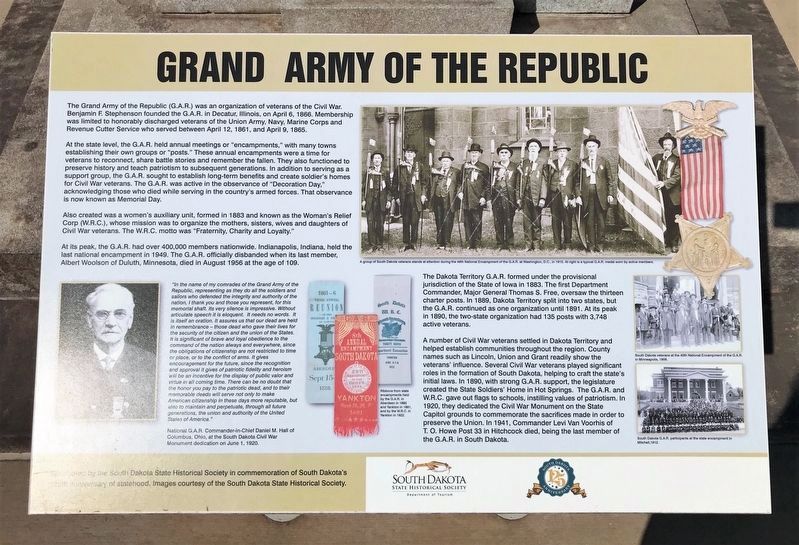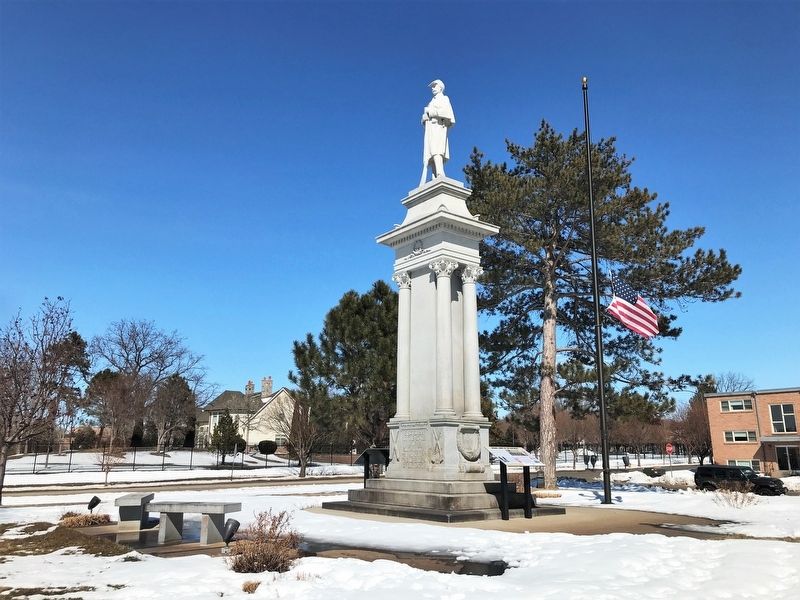Pierre in Hughes County, South Dakota — The American Midwest (Upper Plains)
Grand Army of the Republic
At the state level, the G.A.R. held annual meetings or "encampments," with many towns establishing their own groups or "posts." These annual encampments were a time for veterans to reconnect, share battle stories and remember the fallen. They also functioned to preserve history and teach patriotism to subsequent generations. In addition to serving as a support group, the G.A.R. sought to establish long-term benefits and create soldier's homes for Civil War veterans. The G.A.R. was active in the observance of "Decoration Day," acknowledging those who died while serving in the country's armed forces. That observance is now known as Memorial Day.
Also created was a women's auxiliary unit, formed in 1883 and known as the Woman's Relief Corp (W.R.C.), whose mission was to organize the mothers, sisters, wives and daughters of Civil War veterans. The W.R.C. motto was "Fraternity, Charity and Loyalty."
At its peak, the G.A.R. had over 400,000 members nationwide. Indianapolis, Indiana, held the last national encampment in 1949. The G.A.R. officially disbanded when its last member, Albert Woolson of Duluth, Minnesota, died in August 1956 at the age of 109.
The Dakota Territory G.A.R. formed under the provisional jurisdiction of the State of Iowa in 1883. The first Department Commander, Major General Thomas S. Free, oversaw the thirteen charter posts. In 1889, Dakota Territory split into two states, but the G.A.R. continued as one organization until 1891. At its peak in 1890, the two-state organization had 135 posts with 3,748 active veterans.
A number of Civil War veterans settled in Dakota Territory and helped establish communities throughout the region. County names such as Lincoln, Union and Grant readily show the veterans' influence. Several Civil War veterans played significant roles in the formation of South Dakota, helping to craft the state's initial laws. In 1890, with strong G.A.R. support, the legislature created the State Soldiers' Home in Hot Springs. The G.A.R. and W.R.C. gave out flags to schools, instilling values of patriotism. In 1920, they dedicated the Civil War Monument on the State Capitol grounds to commemorate the sacrifices made in order to preserve the Union. In 1941, Commander Levi Van Voorhis of T. O. Howe Post 33 in Hitchcock died, being the last member of the G.A.R. in South Dakota.
"In the name of my comrades of the Grand Army of the Republic, representing as they do all the soldiers and sailors who defended the integrity and authority of the nation, I thank you and those you represent, for this memorial shaft. Its very silence is impressive. Without articulate speech it is eloquent. It needs no words. It is itself an oration. It assures us that our dead are held in remembrance – those dead who gave their lives for the security of the citizen and the union of the States. It is significant of brave and loyal obedience to the command of the nation always and everywhere, since the obligations of citizenship are not restricted to time or place, or to the conflict of arms. It gives encouragement for the future, since the recognition and approval it gives of patriotic fidelity and heroism will be an incentive for the display of public valor and virtue in all coming time. There can be no doubt that the honor you pay to the patriotic dead, and to their memorable deeds will serve not only to make American citizenship in these days more reputable, but also to maintain and perpetuate, through all future generations, the union and authority of the United States of America."
National G.A.R. Commander-in-Chief Daniel M. Hall of Columbus, Ohio, at the South Dakota Civil War Monument dedication on June 1, 1920.
Captions:
A group of South Dakota veterans stands at attention during the 49th National Encampment of the G.A.R. at Washington, D.C., in 1915. At right is a typical G.A.R. medal worn by active members.
Ribbons from state encampments held by the G.A.R. in Aberdeen in 1885 and Yankton in 1891, and by the W.R.C. in Yankton in 1922.
South Dakota veterans at the 40th National Encampment of the G.A.R. in Minneapolis, 1906.
South Dakota G.A.R. participants at the state encampment in Mitchell, 1912.
Erected 2015 by the South Dakota State Historical Society in commemoration of South Dakota's 125th anniversary of statehood. Images courtesy of the South Dakota State Historical Society.
Topics. This historical marker is listed in these topic lists: Fraternal or Sororal Organizations • War, US Civil. A significant historical date for this entry is April 6, 1866.
Location. 44° 21.832′ N, 100° 20.518′ W. Marker is in Pierre, South Dakota, in Hughes County. Marker is on East Wells Avenue west of South Court Place, on the right when traveling west. Located on the south side of the Civil War Monument in Pierre. Touch for map. Marker is in this post office area: Pierre SD 57501, United States of America. Touch for directions.
Other nearby markers. At least 8 other markers are within walking distance of this marker. Civil War Monument (here, next to this marker); a different marker also named Civil War Monument (here, next to this marker); Coe Crawford, 6th Governor of South Dakota (about 500 feet away, measured in a direct line); Fighting Stallions Memorial (approx. 0.2 miles away); South Dakota World War II Veterans Memorial (approx. ¼ mile away); Flaming Fountain Memorial (approx. ¼ mile away); Revolutionary War Patriots (approx. ¼ mile away); Combat Wounded Veterans (approx. ¼ mile away). Touch for a list and map of all markers in Pierre.
Credits. This page was last revised on April 8, 2023. It was originally submitted on April 7, 2023. This page has been viewed 97 times since then and 22 times this year. Photos: 1, 2. submitted on April 7, 2023.

